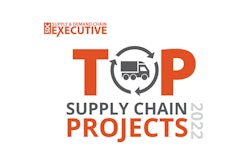
Our 2022 Top Supply Projects award’s mission is to celebrate projects the most transformative and successful cases from the past year. And, this is certainly true for the project featured in this interview.
The editors of Supply and Demand Chain Executive sit down with Fine Tune executives to discuss how the company was able to save one of its clients $100,000 in spend in less than one year after a deep dive into their expenses. The project was selected as one of SDCE's Top Supply Chain Projects of 2022.
Supply & Demand Chain Executive: Please describe the project.
Fine Tune: First, a little context: Fine Tune partners with companies across a variety of industries to source, negotiate, audit, and manage their most complex indirect expenses (i.e., uniform rental, waste disposal, pest control, and security & guard services). These expenses have a whole slew of moving pieces, making them difficult for procurement generalists to wrap their heads around—especially in increasingly lean procurement departments where buyers are saddled with more demands and less time—and thus, effective management of these highly complex expenses is nearly impossible.
Starting in April 2020, we underwent an intensive optimization project for our client—a $3 billion global manufacturer of technically advanced specialty materials and complex components—which focused on their uniform rental category.
Utilizing our proprietary Expense Management Optimization and Auditing Technology (eMOAT) as well as our world-class industry expertise, we reviewed spend and inventory summaries across 16 sites. The following optimization opportunities were uncovered and implemented to secure substantial savings for the client:
- Per site, we recommended right-sized inventories and (where possible) reduced service frequencies of non-garment items. To reach these recommendations, we completed an analysis examining the existing inventories of and spend on non-garment items per site, and compared those inventories across each of the 16 sites while considering site-specific factors such as headcount, facility expanse and function, surrounding climate, etc. This resulted in substantial savings but also ensured no inappropriate changes took place (which could cause product shortages and higher costs as well as field-level workforce frustration).
- Our analysis also identified wearers with greater-than-needed uniform inventories based on job function and site operation. Reducing excess uniform inventories resulted in immediate savings as those items came off the invoices, but also established actual inventories per wearer, which avoided eventual loss charges should an employee not “turn in” non-existent items (during the analysis, it was found that some of the “excess” items billed were non-existent, likely never removed from the invoicing after a past size change, etc.).
- With our client’s direct sale products they were purchasing from uniform suppliers, where strategically appropriate, we made recommendations that they buy them instead from an MRO supplier. The cost benefit of that change resulted from a switch to as-needed-only purchasing and spend, consolidated buying, and in many cases, lower unit prices.
- Finally, although the Fine Tune-negotiated uniform rental agreements includes a cap on loss and ruin charges that can bill, spend that meets or closely reaches the cap does not automatically mean the charges are legitimate and appropriate. So, we performed an analysis of loss and ruin charges per site which revealed egregious spend in this area for some sites compared to other similar sites. We called out the biggest offenders and worked with the uniform suppliers to establish whether the client sites should implement processes and procedures to reduce loss and ruin, or the uniform supplier must assess more accurately what constitutes legitimate loss and ruin charges. Implementing the required changes resulted in sustained lower loss and ruin charges and overall cost.
Supply and Demand Chain Executive: What was the inspiration for this project?
Fine Tune: We have been seeing an alarming imbalance of power between indirect suppliers and customers which is eroding the effectiveness of procurement departments—which, by the way, is only getting worse in 2022. Steadily leaned out since the Great Recession, procurement teams in even the largest organizations are being asked to do more with less, and suppliers have responded by developing increasingly hostile and anti-competitive strategies to grow margins as soon as a deal has been signed.
So, the inspiration behind this project was to implement strategies for regaining lost leverage while protecting the client’s bottom-line.
Supply and Demand Chain Executive: How did it make a difference for the company?
Fine Tune: As a result of Fine Tune’s deep dive into spend and utilization, the client company spent nearly $100,000 less in 2021 on uniform and non-garment rental than in 2020, and more than $205K savings is expected over the client’s remaining uniform rental program term.
Additionally, the project resulted in sustainability improvements—an important benefit of Fine Tune’s optimization projects—with reductions in wasted space within facilities where unused product “sat,” extra trips by the uniform supplier for unnecessary item servicing, uniform wash cycles, and new uniforms injected into the program.
Supply and Demand Chain: What makes this project different than others in the industry?
Fine Tune: So, what sets Fine Tune apart from the competitive landscape are our ongoing and dedicated efforts after the client deals are signed. Our world-class experts, armed with eMOAT, are unmatched in the industry.
Thanks to Fine Tune’s proprietary software, processes, and vigilant client advocacy, the typical contract noncompliance seen in these complex indirect expense categories is identified, disputed, and recovered monthly by Fine Tune and client resources are freed up to focus on other priorities.
Supply and Demand Chain: How did/does this project fit into the overall operations of the company?
Fine Tune: Probably best in the words of our client contact: “Having worked with Fine Tune for many years now, I know full well what they are capable of doing in defending ATI’s bottom line. The most recent project and savings outcomes were eye opening, nonetheless. With the category experts at Fine Tune on my side, I can focus on more strategic efforts across the business and be assured they’ll not only manage the day-to-day but uncover new savings opportunities throughout the year.”
Supply and Demand Chain: What do you think the future holds for this project?
Fine Tune: Given the regained leverage with their uniform rental category and the hard-dollar savings success, the client is evaluating addressing other indirect categories including pest control and security & guard services.
This content was created in partnership with Fine Tune.














![Pros To Know 2026 [color]](https://img.sdcexec.com/mindful/acbm/workspaces/default/uploads/2025/08/prostoknow-2026-color.mduFvhpgMk.png?ar=16%3A9&auto=format%2Ccompress&bg=fff&fill-color=fff&fit=fill&h=135&q=70&w=240)


